Introduction
 Linux Mint is one of the top free operating systems widely used in the world and currently receives the highest hits at DistroWatch.
Linux Mint is one of the top free operating systems widely used in the world and currently receives the highest hits at DistroWatch.
Even though it's an Ubuntu-based system, Linux Mint features only one panel at the bottom which looks closer to the taskbar in the Windows system, and a well-organized start menu complete with a useful Search box. It also pre-installs some proprietary software such as necessary media codecs by default so that you play mp3, mp4 or most other media files with a player right away out of the box.
 The Cinnamon Edition of Linux Mint 13 to 16 uses Cinnamon, instead of GNOME shell, as a user interface for the GNOME-3 desktop environment. And unlike Ubuntu Unity sporting a vertical launcher on the left side of the screen, Cinnamon maintains a traditional layout with a bottom panel and a Mint menu. If you're using this Edition, you might find these tips and tricks useful for working with the system on a PC.
The Cinnamon Edition of Linux Mint 13 to 16 uses Cinnamon, instead of GNOME shell, as a user interface for the GNOME-3 desktop environment. And unlike Ubuntu Unity sporting a vertical launcher on the left side of the screen, Cinnamon maintains a traditional layout with a bottom panel and a Mint menu. If you're using this Edition, you might find these tips and tricks useful for working with the system on a PC.
Note: The steps described in this article work best with the Cinnamon Edition of Linux Mint 13 Maya, 14 Nadia, 15 Olivia and 16 Petra. If you're using the MATE Edition, please check out this article.
Frequently used programs can be easily pinned to the panel.
- Browse to a program from Menu.
- Right click a program, then select "Add to panel" (Alternatively you can drag a program and drop it to the panel launcher).
- Re-order the program icons on the panel launcher as you like by drag-and-drop.
Note: In the same way you can also add a program shortcut to the Desktop or the Favorites located at the left column inside Menu. The Favorites support drag-and-drop and re-ordering. See also "Enable Superbar".
An applet is a small tool or application which you can access directly from the panel for performing a task. Some applets have been enabled by default but you can disable the applets you don't need to use or enable the ones you like pretty easily:
For Linux Mint 14 to 16
- Right click an empty spot on the panel, select "Add applets to the panel".
- In Mint 15 and 16, right-click an applet to add or remove from the panel, or in Mint 14, tick an applet to enable or untick the one you want to hide from the panel, then close the Cinnamon Settings window.
For Linux Mint 13
- Click the Settings (the "^" sign) from the panel, or right-click any applet in the notification area.
- Select "Add/remove applets"
- Tick the applets to enable or untick the ones you want to hide from the panel, then close the Cinnamon Settings window.
Note: You can also add more applets for selection by clicking "Get new applets".
In Windows 7, frequently used programs can be pinned to the taskbar (hence called Superbar) for launching the programs and their icons are highlighted when the programs are running. Likewise, an applet called "Window List with App Grouping" can be added to the panel to achieve almost the same effect.
-
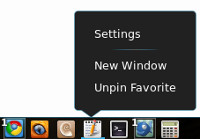 Download the applet Window List with App Grouping and unzip the file.
Download the applet Window List with App Grouping and unzip the file. - Double click "configure.py" to run and install the applet, then log out and back in to the Linux Mint system.
- Follow the tip above to enable the applet "Window List with App Grouping".
- Right click the panel (or click the "^" sign on the panel in older versions) and switch on the Panel Edit mode.
- Drag the applet to the spot you like on the panel, then switch off the Panel Edit mode.
Note: Since this applet serves as a new launcher and the running programs are indicated, you can disable these two applets "Panel Launcher" and "Window List". To add a program shortcut to this new launcher, just drag a program from Menu and drop it to the launcher, and you can pin or unpin programs from the panel as well with a simple right-click.
Like the Windows' Start button, Linux Mint has a Menu button where you can start doing things like running a program, looking for files, log out or quit the system and so on.
The Menu allows you to set your personal preferences with the steps below, for example:
-
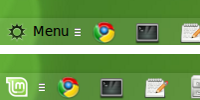 Right click "Menu", select "Configure" (or "Menu settings" in older versions).
Right click "Menu", select "Configure" (or "Menu settings" in older versions). - Replace Menu text to any other word if needed.
- Change the Button icon from /usr/share/cinnamon/theme/menu.png to /usr/lib/linuxmint/mintWelcome/templates/logo.svg, as shown in the screenshot. (Caution: avoid changing to a huge size image which might affect the panel.)
Note: In this Settings window, you can also set Menu hover delay and more.
Quite often a shortcut is automatically added to the Menu when you install an application. But you might also download a program which requires you to manually add a shortcut for it to run from the Menu. This can be done without breaking a sweat.
- Right-click the Mint Menu, select "Configure" then "Open the menu editor" (or select "Edit menu" in older versions).
- Click a software category for example Sound & Video under Applications.
- At the right panel, click "New Item".
- Type in a name for the application, for example, ClipGrab.
- To the right of "Command", browse to the application where you've downloaded, for example, /home/username/Downloads/clipgrab-3.2.1.0
- Click OK and Close buttons.
Note: If an executable file is not accessible, try to add permission to execute the file in the Terminal, for this example assuming the file is extracted to the "Downloads" folder:
cd ~/Downloads
chmod +x clipgrab-3.2.1.0
When you select a theme from Menu > Cinnamon/System Settings > themes, the theme may come with a non-transparent or semi-transparent panel. But you can adjust the level of transparency for the panel if you like. For example, I've selected a Linux Mint theme and I can make it more transparent with the steps below. (Caution: changing the code incorrectly might result in a non-responsive desktop environment.)
- Press Alt-F2, type gksu gedit and press Enter.
- Browse to the folder /usr/share/themes/Linux Mint/cinnamon under "File System" and open this file cinnamon.css
- Search for a section beginning with #panel
- After the last line within the section, insert a new line for example background-color: rgba(0,0,0,0.35); (The alpha value ranges from 0 [full transparency] to 1 [full opacity].)
- Click Save and close the file.
- Switch to another theme and back to the Linux Mint theme to see the result.
When running an application without maximized, Linux Mint always puts it in the left-top corner of the desktop by default unless you configure it with the CompizConfig Settings Manager (CCSM) to set a program window to open up in the center of a desktop. But now CCSM is found not fully compatible with Cinnamon.
As an alternative, you can use this handy tool gDevilspie to automatically detect and move the window of an application, such as Terminal, to the center of the desktop. You just need to set it up once for the applications you need and it's good for use each time you log into the system.
- Go to Menu > Accessories > gDevilspie (Download gDevilspie if not installed)
- Tick "Start devilspie daemon automatically at login"
- Click the Add button and name a new rule.
- Under the Matching tab, tick 'application_name' and type Terminal, for example, in the 'matches' box.
- Under the Actions tab, tick 'center'.
- Click the Save button, then the Start button.
Ideally, the window manager in Linux Mint should restore the last known position of an application window, but it doesn't do that unless an application remembers its own window position. Using this tool, however, you can do more controls over the application windows by the rules you set.
Note 1: In Linux Mint 15 or 16, at time of checking, a bug was reported that gDevilspie did not start. But there's a workaround as follows:
- Press Alt-F2, type gksu gedit and press Enter.
- Browse to File System > usr > bin and open up gdevilspie.
- Search for this line self.UpdateAutostartStatus() and comment it out by adding # at the beginning of the line.
- Save the file and restart gDevilspie.
Note 2: In Linux Mint 16, if you've encountered an error when starting the devilspie daemon, try install devilspie in the Terminal with the command below:
- sudo apt-get install devilspie
When you double-click the title bar of a window, the default setting is to maximize a window. Since there's already a maximize button you can use for this, I always like to change the default setting to rolling up (or 'shading') a window when I double-click on its title bar.
- Go to Menu > System Settings (or Cinnamon Settings)
- Click "Windows" (under Preferences)
- For "Action on title bar double-click", select "Toggle Shade" from the drop-down list.
Now you can roll up a window when you double-click its title bar, and roll it down by double-clicking the title bar again. Simple as that.
Linux Mint (Cinnamon Edition) provides you with several settings for Themes. You can easily select a theme and get a new look for the panel, windows, icons and more in the system.
-
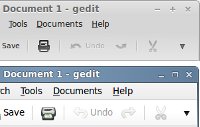 Go to Menu and click the "System Settings" (or "Cinnamon Settings") icon.
Go to Menu and click the "System Settings" (or "Cinnamon Settings") icon. - Click the Themes icon (under Appearance).
- Under the "Installed" (or "Cinnamon themes") tab, select a theme from the list. (In Linux Mint 15 and 16, right-click a theme and select "Apply theme".)
- Under the "Other settings" tab, select a window theme from the drop-down menu to change the window borders and controls (requiring log out and back in to see the results depending on the system version)
You can also make changes by selecting a mouse pointer, an icons theme and other themes under the "Other settings" tab.
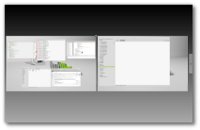 Linux Mint creates two workspaces by default, but you can add more and manage your workspaces pretty easily in several ways:
Linux Mint creates two workspaces by default, but you can add more and manage your workspaces pretty easily in several ways:
- Go to a workspace: get your mouse cursor to the top-left corner of the screen (aka "hot corner" or "Expo") to show all workspaces, then click a workspace to jump to.
- Open an application in a workspace: mouse over a workspace to see all applications in the workspace (aka "Scale"), then select an application.
- Move an application from a workspace to another: drag an application and drop it to another workspace.
- Add a workspace: press the "+" sign or the right-arrow (depending on the version) on the right when in Expo mode.
- Remove a workspace: mouse over a workspace and click the "x" button when in Expo mode.
These shortcuts are also helpful:
- Ctrl+Alt+Up goes to Expo.
- Ctrl+Alt+Down goes to Scale.
- Ctrl+Alt+Left/Right switches to the left/right adjacent workspace.
- Ctrl+Alt+Shift+Left/Right moves the active window to the left/right adjacent workspace.
In Linux Mint 14, 15 or 16, you can also click and edit a workspace title.
In addition to the Computer and Home icons, Linux Mint adds an icon to the desktop for every removable drive that you attach to your system. The icons can be hidden by these steps:
- Go to Menu and click the "System Settings" (or "Cinnamon Settings") icon.
- Click the Desktop icon (under Preferences).
- Untick the items such as computer icon, home icon and mounted volumes if you don't want to show them on the desktop, then close the window.
The drive icons as well as computer and home icons would then disappear from the desktop, simple as that. Remember that you can always access the drives from Menu > Files.
You can right click your desktop, select "Change Desktop Background" and choose any one of the wallpapers pre-installed, but you need to do it each time you want to change a wallpaper. What about changing a wallpaper automatically within a certain time interval? Try Wally.
-
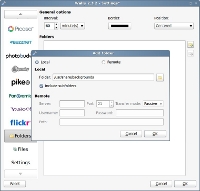 Install Wally from the Ubuntu Apps Directory if the application is not in your system.
Install Wally from the Ubuntu Apps Directory if the application is not in your system. - Press Alt-F2, type wally and press Enter to run it.
- Right-click the Wally icon on the system tray or the notification area, select Settings.
- Click "Folders" in the left column, then add /usr/share/backgrounds to the Folder box and tick "Include subfolders".
- Click "Settings" in the left column, then tick "Play automatically on application starts". You can also check the option to disable splash screen and auto quit if you wish.
- Set the application to auto start, using this tip Auto Start Up an Application (as Wally's option to "Start automatically when system starts" being disabled).
Your wallpaper on the desktop will automatically change following these basic settings when you log back in the system (or right click the Wally icon on the system tray and select "Play").
Keyboard shortcuts are preset in the system, but you can add new ones or change them easily. For instance, you can add a new keyboard shortcut to the text editor Gedit, like below.
For Linux Mint 13
-
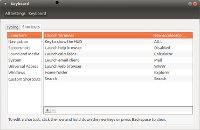 Go to Menu > Preferences > Keyboard.
Go to Menu > Preferences > Keyboard. - Under the Shortcuts tab, click the "+" button to add a custom shortcut.
- Enter gedit to both the Name and Command boxes, then click the Apply button.
- Click on Disabled at the gedit row in the Keyboard Shortcuts window (Disabled is then changed to New shortcut...).
- Press a new key combination, e.g. Ctrl+Alt-G (New shortcut... is then changed to Ctrl+Alt-G). And the shortcut is ready for use!)
For Linux Mint 14 ("Workaround")
The setting for a custom keyboard shortcut didn't work well when tested in Linux Mint 14, but there's a workaround to create a "Keyboard Alternate", using back the old and yet functional keyboard setting:
- Press Alt-F2 and enter gksu gedit /usr/share/applications/keyboard-settings.desktop to create a new desktop file.
-
Paste the following code inside the new file and save it.
[Desktop Entry]
Name=Keyboard
Comment=Change keyboard settings
Exec=gnome-control-center keyboard
Icon=preferences-desktop-keyboard
Terminal=false
Type=Application
StartupNotify=true
Categories=GNOME;GTK;Settings;HardwareSettings;X-GNOME-Settings-Panel;
OnlyShowIn=GNOME;Unity;
X-GNOME-Bugzilla-Bugzilla=GNOME
X-GNOME-Bugzilla-Product=gnome-control-center
X-GNOME-Bugzilla-Component=keyboard
X-GNOME-Bugzilla-Version=3.4.2
X-GNOME-Settings-Panel=keyboard[Desktop Entry]
Name=Keyboard Alternate
Comment=Change keyboard settings
Exec=gnome-control-center keyboard
Icon=preferences-desktop-keyboard
Terminal=false
Type=Application
StartupNotify=true
Categories=GNOME;GTK;Settings;HardwareSettings;X-GNOME-Settings-Panel;
OnlyShowIn=GNOME;Unity;
X-GNOME-Bugzilla-Bugzilla=GNOME
X-GNOME-Bugzilla-Product=gnome-control-center
X-GNOME-Bugzilla-Component=keyboard
X-GNOME-Bugzilla-Version=3.4.2
X-GNOME-Settings-Panel=keyboard
Keywords=Shortcut;Repeat;Blink;
X-Ubuntu-Gettext-Domain=gnome-control-center-2.0
After this workaround, the setting for "Keyboard Alternate" is then available.
Go to Menu > System Tools > System Settings > Keyboard Alternate, and continue to add a new shortcut from Step 2 onwards as used for Linux Mint 13 above.
For Linux Mint 15 and 16
- Go to Menu > System Settings > Keyboard.
- Under the "Keyboard shortcuts" tab, click the "Add custom shortcut" button.
- Enter gedit to both the Name and Command boxes, then click the Add button.
- Click on the unassigned row (unassigned is then changed to New accelerator...).
- Press a new key combination, e.g. Ctrl+Alt-G (New accelerator... is then changed to Ctrl+Alt-g). And the shortcut is ready for use!)
Xkill is part of the X11 utilities pre-installed in Linux Mint and a tool for terminating misbehaving X clients or unresponsive programs. You can easily add a shortcut key to launch xkill with the steps below.
For Linux Mint 13 and 14
-
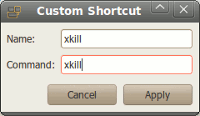 Go to Menu > Preferences > Keyboard. (Use "Keyboard Alternate" for Linux Mint 14 after a workaround)
Go to Menu > Preferences > Keyboard. (Use "Keyboard Alternate" for Linux Mint 14 after a workaround) - Under the Shortcuts tab, click the "+" button to create a custom shortcut.
- Enter xkill to both the Name and Command boxes and click the Apply button.
- Click on Disabled at the xkill row in the Keyboard Shortcuts window (Disabled is then changed to New shortcut...).
- Press a new key combination, e.g. Ctrl+Alt+X (New shortcut... is then changed to Ctrl+Alt+X).
For Linux Mint 15 and 16
- Go to Menu > System Settings > Keyboard.
- Under the "Keyboard shortcuts" tab, click the "Add custom shortcut" button.
- Enter xkill to both the Name and Command boxes and click the Add button.
- Click on the unassigned row (unassigned is then changed to New accelerator...).
- Press a new key combination, e.g. Ctrl+Alt-X (New accelerator... is then changed to Ctrl+Alt-x).
Xkill is ready for use. Press the above key combination to turn the cursor to an X-sign, move the X-sign and drop it into a program interface to terminate the unresponsive program, or cancel the X-sign with a right-click.
If you press Ctrl+Alt+Delete, Linux Mint brings you a menu to log out your system. But for some reason you might encounter that the system freezes, the mouse cursor can't move, neither pressing Ctrl+Alt+Delete can work.
Remember that there's a shortcut key Ctrl+Alt+Backspace that can bring you back to the log-in screen immediately without the need to reboot the system. That's a time saver.
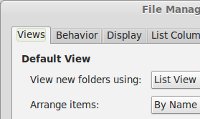 Windows Explorer allows for users to set a default view to all folders. In almost the same way, Linux Mint's File Manager allows for these settings:
Windows Explorer allows for users to set a default view to all folders. In almost the same way, Linux Mint's File Manager allows for these settings:
- Go to "Menu" and click the Files icon.
- At the top of the File Browser, click "Edit" and "Preferences".
- Under Default View, change "Icon View" to "List View", to see more details in columns.
Other various settings, such as single or double click to open items, icon captions, list columns and preview files can be done in the same window as well.
When running the File Manager, you will see that the folder icons are predetermined by the theme you set. If you wish to change a folder icon to another for it to stand out from the system-wide icons, follow these steps:
- In the File Manager, right click a folder icon, select Properties.
- Under the Basic tab, click the icon image to open up the "Select Custom Icon" window.
- In the Location field, type /usr/share/icons, press Enter. (You can hide or unhide the Location field by clicking the Edit button on the top-left of the window.)
- Browse and select an icon you want.
- Click the Open button on the bottom-right of the window to confirm.
Note: You can change your custom folder icon back to the default by clicking the "Revert" button in the "Select Custom Icon" window at Step 2 above.
In the Mint file system, you can use File Manager to browse most files but can only write files in your home folder /home/your_name and its sub-folders such as Desktop and Documents. If you have to rename a folder or write files outside of your home folder using the File Manager, you won't be able to but you can create an advanced file manager for this purpose.
For Linux Mint 13 and 14
- Go to Menu > Preferences > Keyboard (Use "Keyboard Alternate" for Linux Mint 14 after a workaround)
- Under the "Shortcuts" tab, select Custom Shortcuts, then click the "+" sign to create a custom shortcut.
- Enter a name such as Advanced File Manager in the "Name" box.
- Enter gksu nautilus (or gksu nemo for Linux Mint 14) in the "Command" box, then click the Apply button.
- Click on Disabled at the Advanced Nautilus row in the Keyboard Shortcuts window (Disabled is then changed to New accelerator...).
- Press a new key combination, e.g. Ctrl+Alt+N (New accelerator... is then changed to Ctrl+Alt+N).
For Linux Mint 15 and 16
- Go to Menu > System Settings > Keyboard.
- Under the "Keyboard shortcuts" tab, click the "Add custom shortcut" button.
- Enter a name such as Advanced File Manager in the "Name" box.
- Enter gksu nemo to the Command box, then click the Add button.
- Click on the unassigned row (unassigned is then changed to New accelerator...).
- Press a new key combination, e.g. Ctrl+Alt-N (New accelerator... is then changed to Ctrl+Alt-n).
Now you can easily access the Advanced File Manager by pressing the shortcut key you assigned. But be careful since you can use it to delete or change any files on your system.
If you use a PC with an integrated audio device and it has no sound when playing a media file on a player, try these simple steps to set Sound Preferences for your PC. It works for me for the audio device I have.
- Go to Menu > Preferences > Sound to bring up the Sound window.
- Under the Output tab, change the setting to Built-in Audio, Analog Output or other available items from the list.
- Click "Test Sound" or "Test Speakers" to check if it works.
As the items available from the list might differ depending on the hardware devices detected by the system, you might want to try other items in the menus to see if they work for your devices.
Each time when you login to Linux Mint, it may play a login sound depending on the setting. If you don't like how it behaves, you can easily enable or disable a sound, or change it to your favorite sound.
For Linux Mint 13 to 15
- Go to Menu > Administration > Login Window.
- Under the "Accessibility" tab, check or uncheck, or select to a sound you like from the list for "Login successful", click "Play" to try the sound if needed.
- If you want to disable the log-in sound, uncheck "Login successful"
For Linux Mint 16
- Go to Menu > Preferences > Sound.
- With "Starting Cinnamon" having checked, select a sound you like from the drop-down list, click the "Play" button to try the sound if needed.
- If you want to disable the log-in sound, uncheck "Starting Cinnamon"
Log out and log back in to check the new setting for login sound. Similarly you can try out sounds for other actions.
Do you prefer Windows TrueType fonts to the default fonts installed by Linux Mint? The mscorefonts package containing most Microsoft fonts can be installed and configured easily in a few steps below:
-
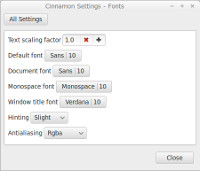 Go to Menu > Terminal.
Go to Menu > Terminal. - Paste sudo apt-get install ttf-mscorefonts-installer into the Terminal (by pressing Ctrl-Shift-V in the Terminal after copying the highlighted code).
- When prompted, use the arrow left/right keys to navigate and agree to the EULA license terms for the install.
- Go to Menu > Cinnamon/System Settings > Fonts.
- Click each of them, pick a font, such as Verdana, and size to configure for window title and so on.
How about installing more TrueType fonts? With your font files, you can manually add them into the system following the steps below:
- Press Alt+F2, paste gksu nemo /usr/share/fonts/truetype (or gksu nautilus /usr/share/fonts/truetype for Linux Mint 13) into the box and hit "Enter" to open the File Manager in the right folder.
- Create a new sub-folder and copy your files ending with .ttf into the sub-folder.
- Enter sudo fc-cache -f -v in the Terminal to rebuild the font information.
Besides this, you can run an application such as Font-Manager to view, install, remove fonts and so on.
Note: If you like the Tahoma font which is not included in the mscorefonts package, you might want to copy the two files tahoma.ttf and tahomabd.ttf from /Windows/Fonts and install them.
Screenlets are small applications to represent things such as sticky notes, clocks, calendars around on your desktop. You can launch a pre-installed screenlet from Screenlets manager, or install a new one into the manager for launching it. Here are the steps for installing and launching a screenlet, for example, WaterMark System Information.
-
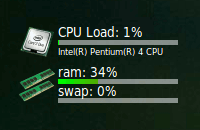 Install Screenlets manager if it has not been added from the Ubuntu Apps Directory. (Note: You can also install it via Software Manager by searching for this application.)
Install Screenlets manager if it has not been added from the Ubuntu Apps Directory. (Note: You can also install it via Software Manager by searching for this application.) - Download the screenlet "WaterMark System Information" to a folder.
- Press Alt-F2, type Screenlets into the box and press Enter to run the manager.
- Click Install, select Install Screenlet and click OK.
- Browse to the folder, select the file downloaded and click "Open" to install the screenlet into the Screenlets manager.
- Select the screenlet "WaterMark" and click "Launch/Add". (Tips: you can add more than one WaterMark screenlet and set it to display other system information.)
More screenlets are available for installation from screenlets.org.
Linux Mint uses OpenJDK by default, but some web services might need the Oracle Java Runtime Environment (JRE) to be installed for running the services properly. If you would like to get the proprietary Oracle Java package for your system, you can download and install it with the steps below:
- Go to Menu > Terminal.
- Enter sudo add-apt-repository ppa:webupd8team/java to add the partner repository.
- Enter sudo apt-get update to update the source list.
- Enter sudo apt-get install oracle-java7-installer
At any time, you can check the Java version you're using and configure it when necessary:
- Enter sudo java -version to check the version of the Java used in the system.
- Enter sudo update-alternatives --config java to choose the default Java for use in the system.
Linux Mint's Software Manager lets you search and get free software. You can go to Menu > Software Manager, type in an application to search, download and install it. You can also go to Menu > Administration > Synaptic Package Manager, type in an application name to search and install a software package from the repositories.
Besides this, you can also go to Ubuntu Apps Directory to find the software products you need. If you like a product on the Directory, just click the orange download button and it opens up in a package manager for you to confirm the install.
Alternatively, you can get the latest freeware applications by clicking the Install this now button from the GetDeb Repository after the getdeb package is installed with the instructions given.
See also our Best Free Software for Linux.
Linux Mint is capable of reading and writing files stored on Windows formatted partitions using NTFS file system, but partitions must be 'mounted' before they can be accessed. With these steps, you can auto mount the drives or partitions without the need to manually mount them for access each time you start up the system. Below are two ways of doing it, either using Storage Device Manager or adding an entry in the fstab file.
Method 1: Using Storage Device Manager (This app is not yet available for Linux Mint 14 [using the upstream Ubuntu 12.10] and the newer versions at time of checking)
-
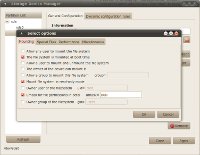 Install Storage Device Manager from Ubuntu Apps Directory if the application is not available in your system.
Install Storage Device Manager from Ubuntu Apps Directory if the application is not available in your system. - Go to Menu > Applications > Administration > Storage Device Manager.
- Extend the list of sda and select the sda you want to auto mount, click 'OK' to configure.
- Click the "Assistant" button.
- Uncheck "Mount file system in read only mode" and keep "The file system is mounted at boot time" checked.
- Click the "Mount", "Apply" then "Close" button, and restart the system.
In case you wish to remove the auto-mount of a certain drive or partition, you can similarly use Storage Device Manager to do the setting.
Method 2: Adding an Entry in the 'fstab' File
- In the Terminal, enter sudo blkid to get the UUID (Universally Unique Identifier) of the partition you want to mount.
- Enter sudo mkdir /media/ntfs to create a mount point
-
Enter gksu gedit /etc/fstab and add the following line in the fstab file:
UUID=1234567890123456 /media/ntfs ntfs rw,nosuid,nodev,noatime,allow_other 0 0 - Replace the above 16-digit number with the UUID you've got from step 1, then click 'Save'.
Restart the system and check if the partition is mounted.
![]() To identify disk partitions by label, either use sudo blkid or ls /dev/disk/by-label -g in the Terminal. To view partition sizes and file systems, enter sudo fdisk -l. Disks app mentioned in "Name or Label a Partition" also gives you a glance of device numbers, partition types, sizes and labels.
To identify disk partitions by label, either use sudo blkid or ls /dev/disk/by-label -g in the Terminal. To view partition sizes and file systems, enter sudo fdisk -l. Disks app mentioned in "Name or Label a Partition" also gives you a glance of device numbers, partition types, sizes and labels.
A USB storage device plugged into the system usually mounts automatically, but if for some reasons it doesn't automount, it's possible to manually mount it with these steps.
- Go to Menu > Terminal.
- Enter sudo mkdir /media/usb to create a mount point called usb.
- Enter sudo fdisk -l to look for the USB drive already plugged in, let's say the drive you want to mount is /dev/sdb1.
-
Enter sudo mount -t vfat /dev/sdb1 /media/usb -o uid=1000,gid=100,utf8,dmask=027,fmask=137 to mount a USB drive formatted with FAT16 or FAT32 system. OR:
Enter sudo mount -t ntfs-3g /dev/sdb1 /media/usb to mount a USB drive formatted with NTFS system.
To unmount it, just enter sudo umount /media/usb in the Terminal.
The File Manager shows the root directory as File System for your Mint system partition. If you have other partitions (or volumes), it shows them as xx GB Filesystem if they’re not named or labelled.
Using Disks app is one of the effective ways to name a partition easily:
-
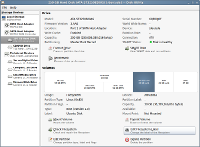 Install Disks app from the Ubuntu Apps Directory if it has not been added.
Install Disks app from the Ubuntu Apps Directory if it has not been added. - Go to Menu > Applications > Preferences > Disks
- Select the item Hard Disk.
- In the Volumes section, click a partition you want to label.
- Click the 'More actions' button below the Volumes section then select "Edit Filesystem Label"
- In the Label box, enter a name, e.g. Data-Disk, and click Apply.
The File Manager should now show the partition label, such as Data-Disk, instead of xx GB Filesystem. This tip is for naming a partition using the application; use other advanced features such as format, edit or delete partition with caution as they can delete data on your disk.
In Windows, you can place a program shortcut in a startup folder for running a program automatically when the system starts. In Linux Mint, you can do the same in this way:
-
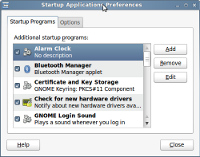 Go To Menu > Preferences > Startup Applications
Go To Menu > Preferences > Startup Applications - Click the "Add" button.
- Name a program.
- Click the "Browse" button and navigate to File System > usr > bin, where programs are usually installed.
- Select a program, click the "Open" button followed by the "Add" button.
The above program will then be listed in additional startup programs. Check if the program runs automatically by logging out and back to the system.
Linux Mint offers you a Mint Display Manager (MDM) to configure a login session. You can use it to change a login screen or a theme you like in a few steps:
-
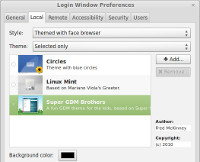 Go to Menu > Administration > "Login Window" to open this window "Login Window Preferences".
Go to Menu > Administration > "Login Window" to open this window "Login Window Preferences". - Under the "theme" tab (or "Local" tab in the older versions), select a built-in theme, then log out and back in to try a new log-in screen.
Get a Theme showing User Names
Under the same tab, you can choose a style such as "GDM" (or "Themed with face browser" in the older versions) and select a theme that lists user names on a login screen and saves you the trouble of typing out a username each time you log in. Besides selecting an existing theme that supports a user list, you can also download a similar theme for installation. For example:
- Download a theme supporting a user list from gnome-look.org, such as Super Brothers mdm (an MDM theme for Linux Mint 13) or Green Glass GDM (a GDM theme for newer Linux Mint versions).
- Drag and drop the theme file (.tar.gz) to the MDM, under the "Theme" or "Local" tab with the style "GDM" or "Themed with face browser" or "GDM" chosen.
- Click "Install", select this new theme and enjoy a new login session with a user list.
Tweak a GDM Theme for MDM Display Manager (For Linux Mint 13 only; newer Linux Mint versions support legacy GDM-2 themes)
Some themes are made for Gnome Display Manager (GDM), but you can also add it to MDM with just a minor tweak if you're using Linux Mint 13:
- Right click a downloaded theme file (.tar.gz) and select "Open With Archive Manager" from the context menu.
- Double click the folder inside the archive manager, then double click this file "GdmGreeterTheme.desktop" in the expanded folder.
- In the opened text editor Gedit, change this line [GdmGreeterTheme] to [MdmGreeterTheme], click "Save", "Update" and close Gedit.
- Right click the file "GdmGreeterTheme.desktop" and rename to "MdmGreeterTheme.desktop", then close the archive manager.
The archived theme file is then tweaked and can be added to the MGM for use.
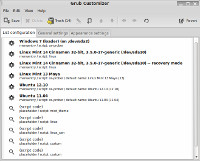 After full installation, Linux Mint is set to be the default operating system to boot up if no key is pressed within a few seconds on a multi-boot system. You might want to set your preferred operating system to boot up by default. This can be done easily with Grub Customizer.
After full installation, Linux Mint is set to be the default operating system to boot up if no key is pressed within a few seconds on a multi-boot system. You might want to set your preferred operating system to boot up by default. This can be done easily with Grub Customizer.
Press Ctrl-Alt-T to call up Terminal, copy following codes and paste (Ctrl-Shift-V) them inside the Terminal to install Grub Customizer.
- sudo add-apt-repository ppa:danielrichter2007/grub-customizer
- sudo apt-get update
- sudo apt-get install grub-customizer
After installation, run Grub Customizer to set the default boot options with the following steps.
- Press Alt-F2, type grub-customizer into the box and press Enter to run it.
- Under the "General Settings" tab, select the default entry you like to boot up from the drop-down menu.
- Adjust the timeout value if needed, then press the Close button and the Save button.
Avoid changing timeout to 0 seconds if you need to select a system to boot up from a multi-boot menu.
Each time when Linux Mint updates to a new Linux kernel, the old one is left behind and the boot menu gets longer. If your new Linux kernel works well, it's safe to clean up the boot menu. Do take these steps carefully as incorrectly hiding the items can make your system unbootable. You can check the Linux kernel version you're running by entering this command line uname -r into the Terminal.
To clean up the boot menu, it's pretty straightforward with Grub Customizer used in the tip above.
- Press Alt-F2, type grub-customizer into the box and press Enter to run it.
- Delete the entries you want to hide from the boot menu. Conversely you can restore the deleted entries from Trash.
- Click the Save button.
A simple command can be entered in the Terminal to schedule a time for the system to shut down.
- Go to Menu > Terminal.
-
Enter sudo shutdown -h +m (replace m with the number of minutes, e.g. +60).
OR: enter sudo shutdown -h hh:mm (replace hh:mm with the time on the 24hr clock, e.g. 23:15). - Enter password and minimize the Terminal window.
The system will then shut down within the minutes or at the time specified. To cancel a scheduled time, enter sudo shutdown -c in the Terminal.
Alternatively, you might want to download and install GShutdown, which is a GUI program for scheduling a time to shutdown the system.
Related Links
- Tips and Tricks for Linux Mint after Installation [Mint 17 - Cinnamon Edition]
- Tips and Tricks for Linux Mint After Installation [Mint 17 - MATE Edition]
- Tips and Tricks for Linux Mint After Installation [Mint 13 to 16 - MATE Edition]
- Tips and Tricks for Ubuntu after Installation [Ubuntu 14.04]
- Tips and Tricks for Ubuntu after Installation [Ubuntu 12.04 and 13.10]
- Best Free Software for Linux
Editor
This category is maintained by volunteer editor Jojo Yee. Registered members can contact the editor with comments or suggestions by clicking here.
You can visit the Google+ profile page of Jojo Yee here.
Tags
things to do after installing Linux Mint, Linux Mint tips and tricks, tweak Linux Mint, Linux Mint 11 Katya, Linux Mint 10 Julia.
Back to the top of the article
 We are looking for people with skills or interest in the following areas:
We are looking for people with skills or interest in the following areas:

Comments
Hi , I've got a problem which I want to be solved.
By accident I removed the applets which indicate the audio volume, the internet connection and the power.
Any idea how I get them back on the panel ?
(I couldn't find them when I wanted to add them back.)
I use LM 15 MATE , if you want to know :-)
Personally, after setup has configured the system as described here http://l4l.su/system/45-linux-mint-16-mate-after-installation.html
Also set up compiz (http://l4l.su/effects/7-how-to-install-compiz-on-ubuntu-and-mate-linux-m...) and the system was amazing. I'm happy with.
Thanks!
It would seem that the only 'patch' available is the HideCaption Titlebar Plus addon (Windows only but many Linux users say it still works): https://addons.mozilla.org/en-US/firefox/addon/hide-caption-titlebar-plu...
Just wish there was some 'native' option to do that.
BTW, CPU with recommended NVidia driver installed hangs around 50 on duo core Intel.
Hope to see this updated for Petra 16!
How can i change top window (not the panel) to be transparent?
I mean, like Firefox has that huge top panel (not menu) that is taking so much property!
Thank you!
Sir, I want to remove the quit/shutdown button from menu. Please advise.
Using Mint 14 Cinnamon for a couple of months now. The system has stopped automounting USB drives/sticks. I don't know why or what changed but how do I now turn the automounting back on? Checking on USB sticks in the Disks app's 'Edit Mount Options' shows that automounting is switched on.
Regards
David
I have taken some screenshots - it appears that it is cinnamon that absorbs CPU most (upto 100% at times).
Yes, Jojoyee, the system works fine and I can access any partition, send e-mails, etc. easily and more quickly than before.
I tend to use GNOME destop; I have an impression it's fater and easier to navigate. When I switch GNOME over to Cinnamon, it becomes very slow, the CPU is working at 98-100% for no (?) apparent reason, as if there was an internal conflict which the system is trying to resolve devoting all CPU resources to the issue. What might it be?
Hi Jojoyee,
Thank you for your help.
What would you advice in the following situation:
PC has two hard discs, one for Win XP, one for Mint.
There are some files on the Win XP partition, but I prefer to work from Mint partition. (1)Should I transfer all the files from Win XP to Mint partition and send them as attachments from there? or (2)is there an easy way of attaching the files to thunderbird directly from Win XP partition, without moving them to Mint partition?
Hi Jojoyee,
Thank you for the advice. I entered [ctr alt n] to get to the Advanced File Manager -> File System-> checked that permissions in Properties were changed to Create & Delete Files.Then (when still in AFM directory) I opened a folder with some pdf files (stored on a memory stick plugged to a usb hub accessible from Windows xp side) and used left button of the mouse to drag and to drop them into an email page opened in Thunderbird editor. However, the file did not appear as attached; there was no error message (telling me that I don't have privilages, etc). When I drag & drop a file from within Mint directory (e.g. Documents) it will show up in the box of the email's attachments. I wonder were the dragged file actually "lands" when I drag it. I couldn't find it. Maybe it doesn't "land" anywhere?
Set a Fully Transparent Panel
For Linux Mint 14
Press Alt-2, type gksu gedit and press Enter.
questions: what is Alt-2 ? It's not Alt F2, is it??
Jojoyee, thank you for this confirmation.
I am an absolute beginner to Mint 14 Cinnamon, but I got hooked on it and learn all the time.
I bought my installation disc and installed it (apparently fine because it is working!).
To change the transparency of the panels followed the instruction:
1.Press Alt-F2, type gksu gedit and press Enter.
then there is a blank "untitled document 1 - gedit" page (without aby files that I could select). Is it possible that ther is no "Theme" on my system ("Cinnamon settings") and I need to download it? How can I check if I have one of the "Themes" installed?
Thank you for your help!
Thank you for the advice. I have modified the css file by entering line:
background-color: rgba(0,0,0,0.35)
The relevant copy of the css file is, as below:
* Panel (panel.js)
* ==============================================================*/
#panel {
background-color: rgba(0,0,0,0.35)
background-gradient-start: #232224;
background-gradient-end: #161617;
background-gradient-direction: vertical;
font-weight: bold;
color: #fff;
font-size: 8pt;
height: 25px;
then I saved it, next returned to the "themes", chose another one and then chose/returned to Jelly Beans again; unfortunately the panels remained unchanged, i.e. not semi-transparent but opaque.
Just wondering where I made a mistake?
Hi Jojoyee.
1. Thank you for the clue. I have copied & pasted the code into the css. Below is the copy taken from the css itself (I couldn't notice any errors there myself).
I saved it, switched Jelly B. to something else, close the "Theme" menu, opened it again, changed the theme back to Jelly B. and restarted computer (not sure if this is actually needed...).
Unfortunately, the panels are the same..., no change.
The new copy of css file:
............
#panel {
background-gradient-start: #232224;
background-gradient-end: #161617;
background-gradient-direction: vertical;
font-weight: bold;
color: #fff;
font-size: 8pt;
height: 25px;
background-color: rgba(0,0,0,0.35);
}
...........
So I am not sure where I went wrong with altering the code.
2. I have a HD and CD drives which I use from WIN XP side of my PC. I can access the files on CD drive & HD from Linux end as well; however, I need to open them as root. I can read the files, edit them, and save on the HD or in a folder which is in root folder/directory.
Is there a way to save/copy/export them to the Owner directory on Linux? This would mean I could access them as easily as the other common files/documents. The files are usually in word or pdf format; sometimes mp3. Is "Create an Advanced File Manager" the section to read & apply?
Thank you for your help!!
Hello Jojoyee.
Thank you for your support!
1.After all the checks that I have done it appears that my display driver doesn't support transparent displays (as you suggested). This must be due the driver installed on the "WIN XP" side of my PC, I assume, so it maybe difficult to find a free update and I don't want to spend money on it. The PC is about 8 years old...
2.You helped me a lot for the advice about Nautilus. I followed the intruction given on this page and now I have full access to files on my WIN XP partitions, can transfer them to the LINUX partirions, work on them, send them via e-mail, etc. This means I can start the process of migration, so that to work from the LINUX end of the PC. I really appreciate its speed and reliablity!
3.I will need some help with installing drivers for my Epson LQ-570+ dot-matrix printer, if you can help me with this. It isn't recognised automatically by the Mint. What is the easiest way to install drivers for it?
Thank you for your great help which is most appreciated!!
1. Yes, Jojoyee - I couldn't find any proprietary Epson LQ 570+ driver for Linux, either. I tried CUPS, but there is an odd thing happening with this option. When I downloaded ppd file from CUPS, and installed it on my PC - the printer prints nonsense. However, when I install CUPS from within Puppy Linux (on the same PC) - it works OK.
2. Re transparent panels: I nstalled Mint 14 on another PC that I have at home. After installation I could select various "Themes" from the available list (e.g."Nighlife Graphite"), but the next day all these options no longer worked. Instead there was a kind of generic (I guess) panel - white & opaque. It doesn't change when a different "Theme" is selected.
3. I have a number of documents (Word, pdf formats) in my Windows' partition (directory ?). I can reach them via Nautilis [ctr alt n] option, can open them and save them in Linux part of the PC. This takes a bit of time, unfortunately. I tried to drag these files (i.e. their icons) to the desktop of Linux (or directly onto the text of my email written on Thunderbird editor), however the method didn't work. I got the following message:
"....There was an error copying the file into /home/owner/Desktop. Error opening file: Permission denied...."
How to get this permission to successfully drag a file from root directory to desktop or (preferably an e-mail text box) ??
Thank you in advance for your advice!!
Thanks Jojoyee.
This is what I have done: selected Home --> selected Desktop --> selected Desktop box (in the top bar) + right click --> left click on Properties --> permissions --> selected "Folder access" allows for "Create and delete files" --> apply permissions to enclosed files.
Then I entered [ctr alt n], entered my password and found a pdf
document in the windows xp directory; left click to drag it to linux desktop screen, but the file didn't get there (the message says:Error while copying "AQA-BYA1-W-MS-JAN01.pdf" There was an error copying the file into /home/owner/Desktop ; Error opening file: Permission denied).
Am I on the right track?
Pages